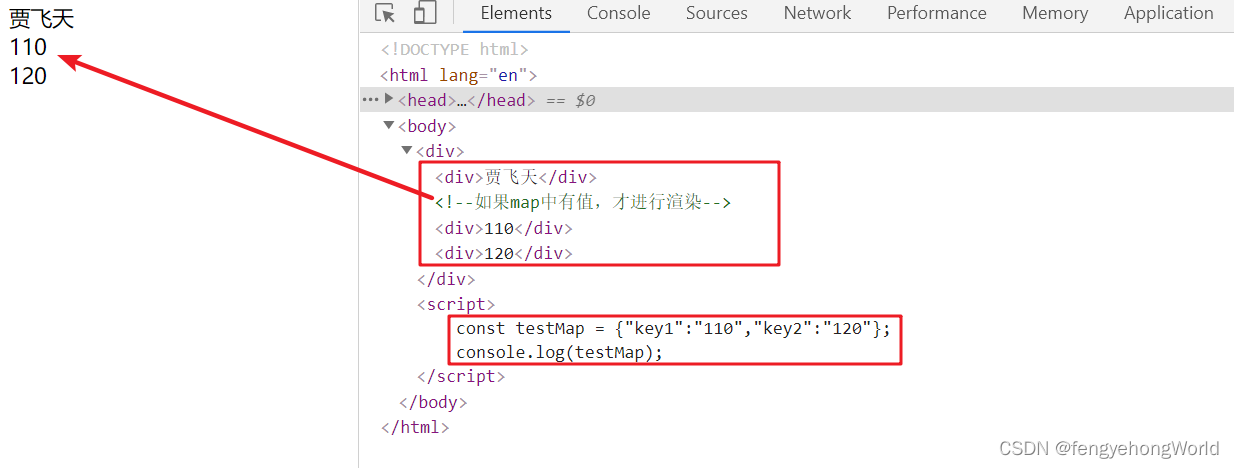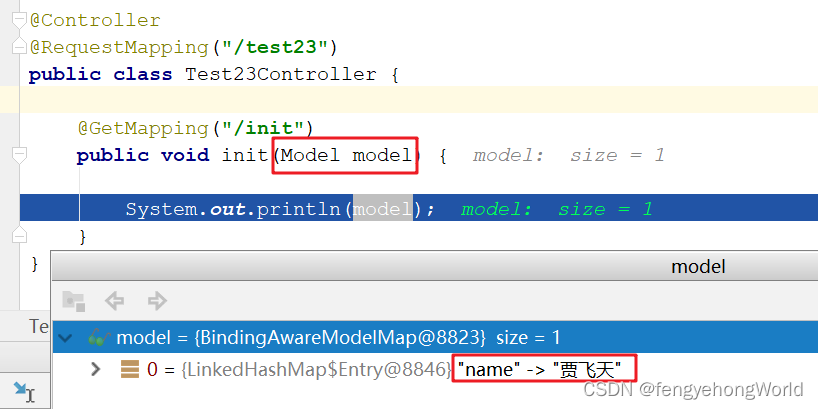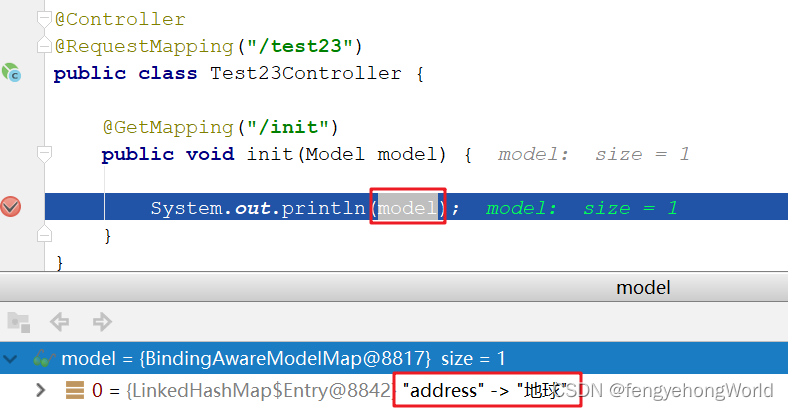Springboot redirect重定向传递参数
参考资料
- 【转载】关于重定向RedirectAttributes的用法
- RedirectAttributes 的使用
- 详解Spring中FlashMap
目录
- 一. RedirecAtrributes传参
- 1.1 前期准备
- 1.2 重定向目标页面接收参数
- 二. FlashMap传参
- 2.1 DispatcherServlet.OUTPUT_FLASH_MAP_ATTRIBUTE
- 2.2 RequestContextUtils.getOutputFlashMap
- 2.3 FlashMapManager
一. RedirecAtrributes传参
-
redirectAttributes.addAttributie("key", value);
这种方法相当于在重定向链接地址追加传递的参数。
以上重定向的方法等同于return "redirect:/重定向目标页面url?key=value",注意这种方法直接将传递的参数暴露在链接地址上,非常的不安全,慎用。 -
redirectAttributes.addFlashAttributie("key", value);
这种方法是隐藏了参数,链接地址上不直接暴露,但是能且只能在重定向的 “页面” 获取 param 参数值。其原理就是将设置的属性放到 session 中,session中的属性在重定向到目标页面后马上销毁。
1.1 前期准备
⏹配置文件
server:servlet:context-path: /jmw
⏹访问url
http://localhost:8080/jmw/test16/init?name=贾飞天&age=18
⏹test16.html
DOCTYPE html>
<html lang="en" xmlns:th="http://www.thymeleaf.org">
<head><meta charset="UTF-8"><title>Titletitle>
head>
<body>
<div><a th:href="@{/test16/changeView(size=${param.size()},name=${param.name})}">页面重定向a>
div>
body>
⏹Thymeleaf渲染之后的效果
<a href="/jmw/test16/changeView?size=2&name=%E8%B4%BE%E9%A3%9E%E5%A4%A9">页面重定向a>
⏹通过RedirectAttributes在重定向之前的页面放入要传递的数据
import org.springframework.web.bind.annotation.*;
import org.springframework.web.servlet.mvc.support.RedirectAttributes;@GetMapping("/changeView")
public String changeView(@RequestParam String name, RedirectAttributes redirectAttributes) {System.out.println(name); // 贾飞天// 准备重定向要传递的参数Map<String, String> mapParam = new HashMap<>();mapParam.put("key1", "110");mapParam.put("key2", "120");// 在重定向时,会将值放入session中,重定向到目标页面之后,会从session中清除redirectAttributes.addFlashAttribute("mapParam1", mapParam);// 相当于拼参数放在url后面redirectAttributes.addAttribute("param2", name);return "redirect:/test17/init";
}
1.2 重定向目标页面接收参数
- 使用
ModelMap来接收 redirectAttributes.addFlashAttribute() 中放入的数据 - 也可以使用
ModelAttribute来接收 redirectAttributes.addFlashAttribute() 中放入的数据 - 使用
@RequestParam来接收 redirectAttributes.addAttribute() 中放入的数据
import org.springframework.stereotype.Controller;
import org.springframework.ui.ModelMap;
import org.springframework.web.bind.annotation.GetMapping;
import org.springframework.web.bind.annotation.ModelAttribute;
import org.springframework.web.bind.annotation.RequestMapping;
import org.springframework.web.bind.annotation.RequestParam;
import org.springframework.web.servlet.ModelAndView;import javax.annotation.Resource;
import javax.servlet.http.HttpServletRequest;
import java.util.Map;@Controller
@RequestMapping("/test17")
public class Test17Controller {@Resourceprivate HttpServletRequest request;@GetMapping("/init")public ModelAndView init(// 使用ModelMap来接收 redirectAttributes.addFlashAttribute() 中放入的数据ModelMap mapParam1,// 也可以使用ModelAttribute来接收 redirectAttributes.addFlashAttribute() 中放入的数据@ModelAttribute("mapParam1") Map<String, String> mapParam2,// 使用@RequestParam来接收 redirectAttributes.addAttribute() 中放入的数据@RequestParam(value = "param2" ,required = false) String param2) {System.out.println(mapParam1); // {mapParam1={key1=110, key2=120}}System.out.println(param2); // 贾飞天Map<String, String[]> parameterMap = request.getParameterMap();System.out.println(parameterMap);/*param2=["贾飞天"]*/// 如果不为空,说明是从其他页面重定向过来的if (!mapParam1.isEmpty()) {// 两种获取方式相同Map mapParam_1 = (Map)mapParam1.getAttribute("mapParam1");System.out.println(mapParam_1.get("key1")); // 110Map mapParam_2 = (Map)mapParam1.get("mapParam1");System.out.println(mapParam_2.get("key2")); // 120// 将map放入request的Attribute中request.setAttribute("testMap", mapParam2);}// 指定跳转的页面ModelAndView modelAndView = new ModelAndView();modelAndView.setViewName("test17");return modelAndView;}
}
⏹前台页面
DOCTYPE html>
<html lang="en" xmlns:th="http://www.thymeleaf.org">
<head><meta charset="UTF-8"><title>Titletitle>
head>
<body>
<div><div>[[${param.param2}]]div><th:block th:if="${not #maps.isEmpty(testMap)}"><div>[[${testMap.key1}]]div><div>[[${testMap.key2}]]div>th:block>div>
body>
<script th:inline="javascript">const testMap = [[${testMap}]];console.log(testMap);
script>
html>

二. FlashMap传参
请求转发前后的request是同一个,所以可以在转发后通过request.getAttribute()拿到转发前通过request.setAttribute()放入的信息。重定向之后的request是新的,转发前通过request.setAttribute()放入的信息,转发后无法通过request.getAttribute()获取到。FlashMap借助 session,重定向前通过FlashMapManager将信息放入FlashMap,
重定向后 再借助 FlashMapManager 从 session中找到重定向后需要的 FalshMap,
从而进行数据传递。- 重定向前通过FlashMap传参的页面,重定向后通过 Model 来获取数据。
2.1 DispatcherServlet.OUTPUT_FLASH_MAP_ATTRIBUTE
在正常的request转发中,无法使用request携带参数。
所以Spring为了解决这个问题,FlashMap主要用于Redirect转发时的参数传递,
我们只需要在redirect之前将需要传递的参数写入OUTPUT_FLASH_MAP_ATTRIBUTE中。
这样在redirect之后的handler中Spring会自动的设置到Model中。
然后就可以通过Model来获取重定向前页面设置的数据。
import org.springframework.stereotype.Controller;
import org.springframework.web.bind.annotation.GetMapping;
import org.springframework.web.bind.annotation.RequestMapping;
import org.springframework.web.servlet.DispatcherServlet;
import org.springframework.web.servlet.FlashMap;
import org.springframework.web.servlet.ModelAndView;
import org.springframework.web.servlet.view.RedirectView;import javax.annotation.Resource;
import javax.servlet.http.HttpServletRequest;
import java.util.Map;@Controller
@RequestMapping("/test22")
public class Test22Controller {@Resourceprivate HttpServletRequest request;@GetMapping("/init")public ModelAndView init() {// 准备转发的数据Map<String, Integer> ageMap = Map.of("age", 28);FlashMap attribute = (FlashMap) request.getAttribute(DispatcherServlet.OUTPUT_FLASH_MAP_ATTRIBUTE);attribute.putAll(ageMap);// 转发RedirectView redirectView = new RedirectView("/test23/init");return new ModelAndView(redirectView);}
}
⏹转发后的效果

2.2 RequestContextUtils.getOutputFlashMap
- RequestContextUtils是
request.getAttribute(DispatcherServlet.OUTPUT_FLASH_MAP_ATTRIBUTE)的简单写法。
import org.springframework.stereotype.Controller;
import org.springframework.web.bind.annotation.GetMapping;
import org.springframework.web.bind.annotation.RequestMapping;
import org.springframework.web.servlet.FlashMap;
import org.springframework.web.servlet.ModelAndView;
import org.springframework.web.servlet.support.RequestContextUtils;
import org.springframework.web.servlet.view.RedirectView;import javax.annotation.Resource;
import javax.servlet.http.HttpServletRequest;
import java.util.Map;@Controller
@RequestMapping("/test22")
public class Test22Controller {@Resourceprivate HttpServletRequest request;@GetMapping("/init")public ModelAndView init() {// 准备转发的数据Map<String, String> nameMap = Map.of("name", "贾飞天");FlashMap outputFlashMap = RequestContextUtils.getOutputFlashMap(request);outputFlashMap.putAll(nameMap);// 转发RedirectView redirectView = new RedirectView("/test23/init");return new ModelAndView(redirectView);}
}
⏹转发后的效果

2.3 FlashMapManager
- FlashMapManager是一个接口,定义了保存FlashMap和获取FlashMap的方法。
import org.springframework.stereotype.Controller;
import org.springframework.web.bind.annotation.GetMapping;
import org.springframework.web.bind.annotation.RequestMapping;
import org.springframework.web.servlet.FlashMap;
import org.springframework.web.servlet.FlashMapManager;
import org.springframework.web.servlet.ModelAndView;
import org.springframework.web.servlet.support.SessionFlashMapManager;
import org.springframework.web.servlet.view.RedirectView;import javax.annotation.Resource;
import javax.servlet.http.HttpServletRequest;
import javax.servlet.http.HttpServletResponse;@Controller
@RequestMapping("/test22")
public class Test22Controller {@Resourceprivate HttpServletRequest request;@Resourceprivate HttpServletResponse response;@GetMapping("/init")public ModelAndView init() {// 准备转发的数据FlashMap flashMap = new FlashMap();flashMap.put("address", "地球");FlashMapManager flashMapManager = new SessionFlashMapManager();flashMapManager.saveOutputFlashMap(flashMap, request, response);// 转发RedirectView redirectView = new RedirectView("/test23/init");return new ModelAndView(redirectView);}
}
⏹转发后的效果

本文来自互联网用户投稿,文章观点仅代表作者本人,不代表本站立场,不承担相关法律责任。如若转载,请注明出处。 如若内容造成侵权/违法违规/事实不符,请点击【内容举报】进行投诉反馈!